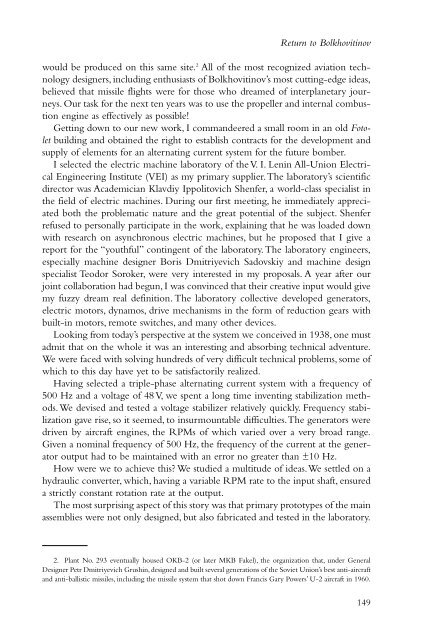to open next chapter. - NASA's History Office
to open next chapter. - NASA's History Office
to open next chapter. - NASA's History Office
Create successful ePaper yourself
Turn your PDF publications into a flip-book with our unique Google optimized e-Paper software.
Return <strong>to</strong> Bolkhovitinov<br />
would be produced on this same site. 2 All of the most recognized aviation technology<br />
designers, including enthusiasts of Bolkhovitinov’s most cutting-edge ideas,<br />
believed that missile flights were for those who dreamed of interplanetary journeys.<br />
Our task for the <strong>next</strong> ten years was <strong>to</strong> use the propeller and internal combustion<br />
engine as effectively as possible!<br />
Getting down <strong>to</strong> our new work, I commandeered a small room in an old Fo<strong>to</strong>let<br />
building and obtained the right <strong>to</strong> establish contracts for the development and<br />
supply of elements for an alternating current system for the future bomber.<br />
I selected the electric machine labora<strong>to</strong>ry of the V. I. Lenin All-Union Electrical<br />
Engineering Institute (VEI) as my primary supplier.The labora<strong>to</strong>ry’s scientific<br />
direc<strong>to</strong>r was Academician Klavdiy Ippoli<strong>to</strong>vich Shenfer, a world-class specialist in<br />
the field of electric machines. During our first meeting, he immediately appreciated<br />
both the problematic nature and the great potential of the subject. Shenfer<br />
refused <strong>to</strong> personally participate in the work, explaining that he was loaded down<br />
with research on asynchronous electric machines, but he proposed that I give a<br />
report for the “youthful” contingent of the labora<strong>to</strong>ry.The labora<strong>to</strong>ry engineers,<br />
especially machine designer Boris Dmitriyevich Sadovskiy and machine design<br />
specialist Teodor Soroker, were very interested in my proposals. A year after our<br />
joint collaboration had begun, I was convinced that their creative input would give<br />
my fuzzy dream real definition. The labora<strong>to</strong>ry collective developed genera<strong>to</strong>rs,<br />
electric mo<strong>to</strong>rs, dynamos, drive mechanisms in the form of reduction gears with<br />
built-in mo<strong>to</strong>rs, remote switches, and many other devices.<br />
Looking from <strong>to</strong>day’s perspective at the system we conceived in 1938, one must<br />
admit that on the whole it was an interesting and absorbing technical adventure.<br />
We were faced with solving hundreds of very difficult technical problems, some of<br />
which <strong>to</strong> this day have yet <strong>to</strong> be satisfac<strong>to</strong>rily realized.<br />
Having selected a triple-phase alternating current system with a frequency of<br />
500 Hz and a voltage of 48 V, we spent a long time inventing stabilization methods.We<br />
devised and tested a voltage stabilizer relatively quickly. Frequency stabilization<br />
gave rise, so it seemed, <strong>to</strong> insurmountable difficulties.The genera<strong>to</strong>rs were<br />
driven by aircraft engines, the RPMs of which varied over a very broad range.<br />
Given a nominal frequency of 500 Hz, the frequency of the current at the genera<strong>to</strong>r<br />
output had <strong>to</strong> be maintained with an error no greater than ±10 Hz.<br />
How were we <strong>to</strong> achieve this? We studied a multitude of ideas.We settled on a<br />
hydraulic converter, which, having a variable RPM rate <strong>to</strong> the input shaft, ensured<br />
a strictly constant rotation rate at the output.<br />
The most surprising aspect of this s<strong>to</strong>ry was that primary pro<strong>to</strong>types of the main<br />
assemblies were not only designed, but also fabricated and tested in the labora<strong>to</strong>ry.<br />
2. Plant No. 293 eventually housed OKB-2 (or later MKB Fakel), the organization that, under General<br />
Designer Petr Dmitriyevich Grushin, designed and built several generations of the Soviet Union’s best anti-aircraft<br />
and anti-ballistic missiles, including the missile system that shot down Francis Gary Powers’ U-2 aircraft in 1960.<br />
149
















